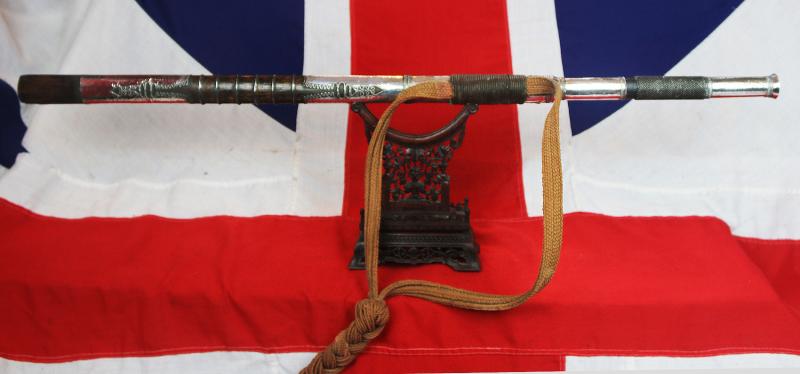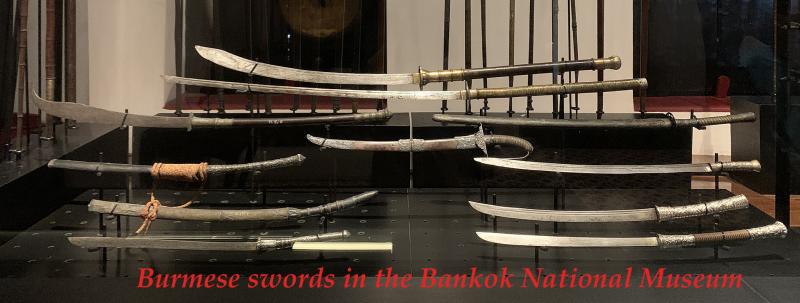A Beautiful, Very long, Antique Burmese Dha Sword in Silver, with Silver Mounted Scabbard and Baldric, Probably Shan States, Konbaung Dynasty (1752-1885 c.e.)
This Burmese Dha sword features a long handle with ornamental silver fittings, the silver scabbard with more elaborate fittings as well as a floral motif.
Both have long, slightly-curved, single-edged steel blades that end in a point. Each has a wooden scabbard that is partly encased in silver. The silver used on these dhas is very close to being pure. The silver is arrayed such that panels of wood are revealed, bordered by silver filigree work. The contrast between the warm colour of the wood and the silver casings is particularly pleasing.
The handles of hilts are similarly encased in silver. The scabbard is covered in silver wire woven in a ‘chicken-wire’ design.
The dha is the single edged sword most typically associated with Burma (modern Myanmar). These are still used to this day by peoples such as the Shan essentially as a combination of machete and weapon. The term "dha" really means a knife, and the sword is more fully known as a dha iwe. The exact origins of this weapon are hotly debated but certainly have a long history in the region judging by their being depicted in the 12th century AD temple complex at Angkor Wat. Conceivably they had a very long history as a bush knife, but were also useful from horseback as the long handle gave them excellent reach (the Angkor Wat examples are of horsemen). Like all traditions of fighting, Burma has it's own highly developed form of martial art, known as banshay. It is closely related to the martial arts systems of the region, and includes use of the dha. In the banshay tradition, learners would have their swords locked in their scabbards, and with this they would practice. If the sword was needed, the scabbard would have to be broken.
The Shan are descendants of the oldest branch of the Tai-Shan, known as Tai Luang (Great Tai) or Tai Yai (Big Tai). The Tai-Shan who migrated to the south and now inhabit modern-day Laos and Thailand are known as Tai Noi (or Tai Nyai), while those in parts of northern Thailand and Laos are commonly known as Tai Noi (Little Tai - Lao spoken) The Shan have inhabited the Shan Plateau and other parts of modern-day Burma as far back as the 10th century AD. The Shan kingdom of Mong Mao (Muang Mao) existed as early as the 10th century AD but became a Burmese vassal state during the reign of King Anawrahta of Pagan (1044–1077).
After the Pagan kingdom fell to the Mongols in 1287, the Tai-Shan peoples quickly gained power throughout South East Asia. The present-day boundary of southern Shan State vis-à-vis Thailand was formed shortly after. Burma lost southern Lan Na (Chiang Mai) in 1776 and northern Lan Na (Chiang Saen) in 1786 to a resurgent Bangkok-based Siam, ending an over two-century Burmese suzerainty over the region. It retained only Kengtung on the Burmese side. The southern border of Shan State remained contested in the following years. Siam invaded Kengtung in (1803–1804), (1852–1854), and Burma invaded Lan Na in 1797 and 1804. Siam occupied Kengtung during World War II (1942–1945).
Throughout the Burmese feudal era, Shan states supplied much manpower in the service of Burmese kings. Without Shan manpower, the Burmans alone would not have been able to achieve their much vaunted victories in Lower Burma, Siam, and elsewhere. Shans were a major part of Burmese forces in the First Anglo-Burmese War of 1824–1826, and fought valiantly—a fact the British commanders acknowledged.
After the Second Anglo-Burmese War of 1852, the Burmese kingdom was reduced to Upper Burma alone. The Shan states—especially those east of the Salween River, were essentially autonomous entities, paying token tribute to the king. In 1875, King Mindon, to avoid certain defeat, ceded Karenni states, long part of Shan states, to the British. When the last king of Burma, Thibaw Min, ascended the throne in 1878, the rule of central government was so weak that Thibaw had to send thousands of troops to tame a rebellion in the Shan state of Mongnai and other eastern Shan states for the remainder of his year reignOn 28 November 1885, the British captured Mandalay, officially ending the Third Anglo-Burmese War in 11 days. But it took until 1890 for the British to subdue all of Shan states. Under the British colonial administration, established in 1887, the Shan states were ruled by their saophas as feudatories of the British Crown. The British placed Kachin Hills inside Mandalay Division and northwestern Shan areas under Sagaing Division. In October 1922, the Shan and Karenni states were merged to create the Federated Shan States, under a commissioner who also administered the Wa State. This arrangement survived the constitutional changes of 1923 and 1937.
During World War II, most of Shan States were occupied by the Japanese. Chinese Kuomingtang (KMT) forces came down to northeastern Shan states to face the Japanese. Thai forces, allied with the Japanese, occupied Kengtung and surrounding areas in 1942
43 inches long overall, blade 29 inches
Every single item from The Lanes Armoury is accompanied by our unique Certificate of Authenticity. Part of our continued dedication to maintain the standards forged by us over the past 100 years of our family’s trading, as Britain’s oldest established, and favourite, armoury and gallery
Code: 25028









